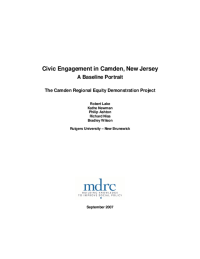Civic Engagement in Camden, New Jersey: A Baseline Portrait
Perhaps more than most cities, Camden, New Jersey, has suffered from the declining fortunes of urban centers in the United States in the past half-century. The steady exodus of middle-income residents and businesses that started in the postwar years has left the city with concentrated poverty, falling property values, a dwindling tax base, and inadequate resources to cover the city’s basic costs and services. Recently, however, Camden has been at the center of private and public redevelopment activities and reforms that seek to transform the city’s landscape, create local and regional housing and employment opportunities for its residents, and position Camden to be an important participant in the region’s economic development activities. In addition to millions of dollars in private investment in the waterfront area, the State of New Jersey has appointed a receivership executive over Camden who has been charged with reorganizing the municipal government and allocating millions of dollars in state aid to underwrite infrastructure improvements and other development projects. The enormity of problems faced by Camden suggests the need for work on many levels, both within the city and within the region of which it is an interdependent part. The Camden Regional Equity Demonstration Project, a Ford Foundation-funded initiative that encourages closely coordinated local and suburban redevelopment strategies so that opportunity is more equitably distributed in South Jersey, offers an opportunity to examine the assumptions, contending visions, and implementation challenges at the center of a growing debate on rebuilding urban cores. MDRC, in partnership with the Center for Urban Policy Research at Rutgers University, is conducting a multiyear study of the origins, implementation, achievements, and challenges of redevelopment strategies, some of which are unfolding in the city of Camden and others evolving in the suburbs of South Jersey. This report from the project, written by our partners at Rutgers University, focuses on the city of Camden and takes a look at the difficult challenge of fostering meaningful and effective civic engagement in a complex, state-mandated redevelopment initiative. It describes how the redevelopment initiative has been stymied by a legacy of municipal mismanagement, a resulting mistrust of officials by residents, conflict among the various players in the city, and the political pressure of a very short timeline for redevelopment. At the same time, Camden and its citizens can point to a few examples of positive civic engagement in the revitalization process, which may offer a framework for future progress. For the broader field of urban development, Camden’s experiences illustrate why effective civic engagement should be an important component of revitalization plans, and how ineffective or insufficient civic engagement can undermine even the best-intentioned redevelopment effort. Given the current state of debate over eminent domain, this report documents the controversy that can arise over its use and the political limbo that results when projects become the subject of lawsuits. In Camden, the tensions inherent in any redevelopment effort have been magnified by the State of New Jersey’s takeover of government activity, a process which, however necessary, effectively disenfranchised local citizens. Without elected representation, citizen involvement in decision-making takes on added urgency. This report underscores both the importance and the challenges of citizen engagement in the redevelopment process, engagement that may be critical to ensuring the legitimacy of redevelopment decisions. The report also documents how conflict around the scale of intervention remains a vital theme for urban planning and development. During the period described in the report, civic engagement dynamics in Camden have sometimes set locally-based, community development goals against City officials’ visions of larger-scale redevelopment. Despite some efforts to engage the community by the City, such differences proved impossible to overcome because many citizens felt they weren’t being heard in the decision-making process. At the time of publication, events in Camden highlight how difficult it remains to accomplish initiatives of large magnitude. The court-ordered stoppage of the three main redevelopment projects in Camden as a result of citizen-initiated lawsuits, as well as the resignations of the two top officials overseeing the initiative, underscore the challenges that continue to plague the redevelopment effort and the uncertainty that characterizes revitalization in cities like Camden. The Camden Redevelopment Agency and community residents have recently embarked on re-planning in targeted neighborhoods with these challenges in mind. We hope that the lessons about civic engagement and municipal capacity described in this report will prove useful to the newly appointed leaders of the Camden Redevelopment Agency as they move forward. As the authors conclude, the issue is not whether civic engagement is necessary or possible, but rather how, when, and under what terms it occurs. Future reports on Camden from MDRC will revisit issues of citizen involvement as well as tackle broader issues concerning the revitalization effort, including efforts to fit Camden into a regional redevelopment strategy. Gordon L. Berlin |






